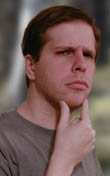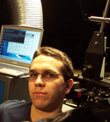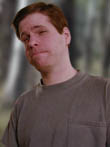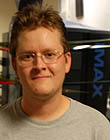|
|
This topic comprises 3 pages: 1 2 3
|
|
Author
|
Topic: Kodak Admits that Film Uses Pixels!
|
|
|
|
|
|
|
|
|
|
|
|
|
|
|
John Pytlak
Film God

Posts: 9987
From: Rochester, NY 14650-1922
Registered: Jan 2000
|
 posted 04-06-2004 08:38 PM
posted 04-06-2004 08:38 PM





Kodak LIGHTNING Laser Recorders:
http://www.cinesite.com/?1231&0&2421
quote:
KODAK LIGHTNING LASER RECORDERS
The Lightning recorder's technology is unique in that it uses red, green and blue lasers to expose negative film. The three lasers write directly to each color layer of the intermediate stock. This combination produces images of unparalleled sharpness and color saturation. The system's 10 bit (per color per pixel) log space retains all the film's enormous density range, while the lasers' extremely wide dynamic range ensures that the quality of the new negative is absolutely optimised
Kodak's laser recorder polygon has 16 facets and spins at 6120 revolutions per minute (rpm). The imaging lens is a high-performance, color-corrected f/theta lens which was custom designed for the recorder. The digital datapath of the Lightning laser recorder also includes color matrix and aperture correction boards. The color matrix is used to help eliminate color crosstalk on the negative. The aperture correction board applies a compensating correction for the combined optical losses of the film recorder ensuring that the full detail and grain structure of the film is preserved.
It is extremely important that the grain content in the recorded shot matches exactly that of the original film, so that when an added effect is edited into the finished sequence there is no discernible change in grain, a telltale sign of an added effects shot. Cinesite outputs to 5242 intermediate stock, which is virtually grainless (ASA 3) and has the ability to record the grain pattern from faster stocks so that the digital transformation is unnoticeable in the final edit. The lasers that the Kodak system uses are more intense than CRT's and are able to record out the full dynamic range of any other scanned original negative stock. At Cinesite the lasers are calibrated to give a maximum dynamic range of 2.046 density units to match the capability of the 5242 stock. When used with the Lightning film scanner, the Lightning laser recorder's output is nearly impossible to distinguish from the camera original
Cinesite filmout request form:
http://www.cinesite.com/img/Cinesite/Hollywood_Scanning/forms/filmout_request.pdf
Arrilaser recorder:
http://www.arri.com/prod/digital/arrilaser/index.php
quote:
frame size: 35mm full aperture, 4 perf.
nominal spot size: 0.006 mm (4K resolution)
0.012 mm (2K resolution)
image format: 4096 x 3112 pixels (4K resolution)
2048 x 1556 pixels (2K resolution)
dynamic range: 2.046 status M density above Dmin on intermediate filmstock
MTF: 40% @ 40 lp/mm; horizontal and vertical
film transport: 1000 foot and 2000 foot magazines supply and take-up separate
shuttle mode: > 5 frames per second
host computer: Windows XP platform
user interface: calibration function
job management
optional: visual control of images
network interface: Fast or Gigabit Ethernet, others optional
physical dimensions: size: 115 x 115 x 65 cm
weight: approx. 285 kg
electrical requirements: input voltage: 240 V
power consumption: < 800 W incl. host computer
frequency: 50 Hz, 60 Hz
operating environment: room temperature: 19 - 24° Celsius
| IP: Logged
|
|
|
|
John Pytlak
Film God

Posts: 9987
From: Rochester, NY 14650-1922
Registered: Jan 2000
|
 posted 04-06-2004 08:45 PM
posted 04-06-2004 08:45 PM





Kodak Cinesite scanners:
http://www.cinesite.com/?1231&0&1269
quote:
NORTHLIGHT SCANNER
Cinesite recently installed Northlight film scanners at both the Los Angeles and London facilities. This new generation of scanners, developed by FilmLight in London, utilizes an 8K tri-linear CCD array manufactured by Kodak to convert film at either three- or four-perforations of height per frame to digital files. Cinesite can now scan 35 mm color negative film at speeds around four times faster than the previous generation of machines making it more practical to convert nuances in colors, contrast and other details captured on the original negative to digital files.
quote:
KODAK LIGHTNING 35MM SCANNER
The Lightning film scanner, the finest system available for digital imaging, is the cornerstone of Cinesite's scanning capability. Featuring CCD sensor technology with three linear photosite arrays of 4,096 pixels each, the scanner handles the most common 35mm aspect ratios of Full Aperture (1024,2048 & 4096 lines resolution), Cinemascope and Academy (914, 1828 & 3656), and Vista Vision format (6144).
At 4000 lines, the Lightning scanner captures 38.9mb of data per frame from the standard 35mm format, Cinemascope captures 45.5mb, Full Aperture 51mb and Vista Vision exactly 100mb. The 4000 line resolution provides more than sufficient headroom for the level of image manipulation upon which our customers stake their reputations.
Each CCD array has a custom filter tuned to the dye densities of Eastman Color film, and is capable of capturing the full dynamic range of the images being scanned.
quote:
GENESIS PLUS 65MM SCANNER
Cinesite is excited about the tremendous growth happening in the large format, special venue industry. The Kodak Genesis Plus scanner brings the same dynamic and robust digital tools to the 65mm wide-screen filmmaker that are available with the 35mm Lightning scanner. The Genesis Plus handles 5, 8, and 15 perf formats.
| IP: Logged
|
|
|
|
|
|
Wolff King Morrow
Master Film Handler

Posts: 490
From: Denton, TX, USA
Registered: Feb 2004
|
 posted 04-07-2004 02:56 AM
posted 04-07-2004 02:56 AM





quote:
KODAK LIGHTNING 35MM SCANNER
The Lightning film scanner, the finest system available for digital imaging, is the cornerstone of Cinesite's scanning capability. Featuring CCD sensor technology with three linear photosite arrays of 4,096 pixels each, the scanner handles the most common 35mm aspect ratios of Full Aperture (1024,2048 & 4096 lines resolution), Cinemascope and Academy (914, 1828 & 3656), and Vista Vision format (6144).
At 4000 lines, the Lightning scanner captures 38.9mb of data per frame from the standard 35mm format, Cinemascope captures 45.5mb, Full Aperture 51mb and Vista Vision exactly 100mb. The 4000 line resolution provides more than sufficient headroom for the level of image manipulation upon which our customers stake their reputations.
Edit:
So I'm wondering, are these scanners for when studios film natural scenes and wish to add digital effects? What about when the entire project is digital to begin with? How are the image files transferred to film?
Edit 2:
Nevermind. I went to the web site to learn more about how they operate. Very cool stuff!
| IP: Logged
|
|
David M. Dorn
Film Handler
Posts: 35
From: Hartford, CT USA
Registered: Mar 2004
|
 posted 04-07-2004 10:38 AM
posted 04-07-2004 10:38 AM




IS 4K the breakthough point for digital cinema?
Dalsa, the Canadian chipmakeer ( imaging chips for the Mars rovers) will again be demonstrating a revised prototype of their 4K digital camera at the forthcoming NAB show. Thie "Origin" camera can record 4K, 4:4:4 RGB, 24fps with slow motion capablilities. The present stumbling block is the data rate, 1.2Gis/sec, higher than Infiniband can handle. However they hold a cinema use license for the L3 compression algoritym which is claimed to be lossless.
With more films going to Digit Intermediate because of CGI and Color timing needs, 4k is probably going to become more commeon in post production.
IF, and a big if, the the whole work flow, camera/DI/Release, can be held at 4K, it seems to me that Digital may finally arrive. At 4K on screen, the exhibitors would be able to see at stable technology (I know about Moore's law) to make the investment needed also assuming that the majors pass along some of the print and distribution savings.
BTW...Dalsa will be showing film and Origin digital sequences shot side by side at NAB. If any one on this list is attending pleaae post a report on the Dalsa presentation.
| IP: Logged
|
|
|
|
|
|
All times are Central (GMT -6:00)
|
This topic comprises 3 pages: 1 2 3
|
Powered by Infopop Corporation
UBB.classicTM
6.3.1.2
The Film-Tech Forums are designed for various members related to the cinema industry to express their opinions, viewpoints and testimonials on various products, services and events based upon speculation, personal knowledge and factual information through use, therefore all views represented here allow no liability upon the publishers of this web site and the owners of said views assume no liability for any ill will resulting from these postings. The posts made here are for educational as well as entertainment purposes and as such anyone viewing this portion of the website must accept these views as statements of the author of that opinion
and agrees to release the authors from any and all liability.
|

 Home
Home
 Products
Products
 Store
Store
 Forum
Forum
 Warehouse
Warehouse
 Contact Us
Contact Us




 Printer-friendly view of this topic
Printer-friendly view of this topic








![[Cool]](cool.gif)
![[Big Grin]](biggrin.gif)


![[Wink]](wink.gif)
![[thumbsup]](graemlins/thumbsup.gif)


![[Smile]](smile.gif)




